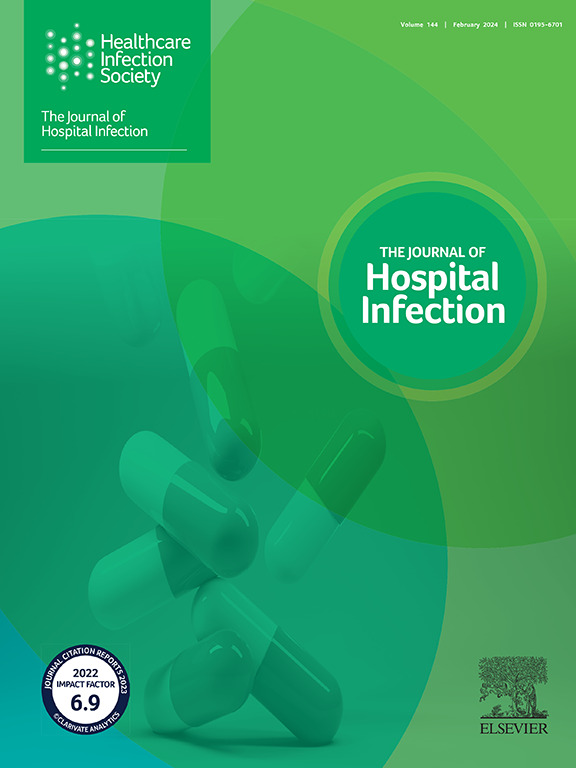Prevalence of carbapenem-resistant Enterobacterales in healthcare and community settings in the UK: a systematic review and meta-analysis
IF 3.1
3区 医学
Q1 INFECTIOUS DISEASES
引用次数: 0
Abstract
Carbapenemase-producing carbapenem-resistant Enterobacterales (CP-CRE) pose a growing threat in the UK, with increasing prevalence in recent years associated with higher morbidity, mortality and healthcare costs. This review synthesizes evidence in the prevalence of CP-CRE in UK healthcare and community settings. A systematic review was conducted across major five databases and two preprint websites until 14th February 2024. Eligible records were assessed in Covidence, with metadata extracted and quality evaluated using an adapted Newcastle–Ottawa Scale. Pooled CP-CRE prevalence rates with 95% confidence intervals (CIs) were assessed using chi2 and I2,where the Q statistic followed an X2 distribution (with k-1 degrees of freedom). Publication bias was evaluated using Egger's test and funnel plot, with sensitivity analyses performed. Among 1344 screened records, 32 studies were included. The overall pooled prevalence of CRE and carbapenemase-producing Enterobacterales (CPE) in healthcare settings was 1.17% (95%Cl 0.29–2.51%, I2 = 99.70%, N = 171,107) and 1.06% (95%Cl 0.59–1.64%; I2 = 97.60, N = 263,833), respectively. CPE pooled prevalence was higher in healthcare carriage samples at 1.23% (95%Cl: 0.68–1.91%; I2 = 98.10%; N = 262,524) than infection samples at 0.03% (95%Cl: 0.00–0.37%; I2 = 0.00%; N = 888). Risk-based admission screening identified a higher CPE proportion of 1.27% (95%Cl: 0.97–1.60%; I2 = 67.30%; N = 24,763) compared with universal hospital screening at 0.82% (95%Cl: 0.28–1.65%; I2 = 97.90%; N = 232,033). In the community, only two studies reported CPE prevalence (0.11%; 95%Cl: 0.00–0.79%; I2 = 52.60; N = 2630) from carriage samples using point prevalence surveys, showing low prevalence. This review provides an overview of CP-CRE prevalence across healthcare and community settings in the UK. Our findings support the national surveillance of CP-CRE in the UK, enabling more targeted screening efforts for CP-CRE detection.
英国卫生保健和社区环境中碳青霉烯耐药肠杆菌的患病率:系统回顾和荟萃分析。
碳青霉烯酶产生的碳青霉烯耐药肠杆菌(CP-CRE)在英国构成了越来越大的威胁,近年来发病率、死亡率和医疗费用都有所增加。本综述综合了英国医疗保健和社区环境中CP-CRE患病率的证据。方法:截止到2024年2月14日,对5个主要数据库和2个预印本网站进行系统评价。在covid - 19中评估合格的记录,提取元数据并使用适应的纽卡斯尔-渥太华量表评估质量。使用ChI2和I2评估95%置信区间的CP-CRE合并患病率,其中Q统计量遵循X2分布(具有k-1自由度)。采用Egger检验和漏斗图评价发表偏倚,并进行敏感性分析。结果:在1344份筛选记录中,纳入32项研究。医疗机构CRE和CPE的总总患病率分别为1.17% (95%Cl 0.29%-2.51%, I2= 99.70%, n-171,107)和1.06% (95%Cl 0.59%-1.64%, I2= 97.60, n=263,833)。卫生运输车样本CPE总患病率为1.23% (95%Cl: 0.68%-1.91%; I2=98.10%; n=262,524),高于感染样本的0.03% (95%Cl: 0.0000% -0.37%; I2=0.00%; n=888)。基于风险的入院筛查发现CPE比例为1.27% (95%Cl: 0.97%-1.60%; I267.30%; n=24,763),而普遍医院筛查的CPE比例为0.82% (95%Cl: 0.28%-1.65%; I2= 97.90%; n=232,033)。在社区,只有两项研究报告了采用点患病率调查的马车样本的CPE患病率(0.11%;95%Cl: 0.00%-0.79%; I2=52.60; n= 2630),显示患病率较低。结论:本综述概述了英国医疗保健和社区环境中CP-CRE的患病率。我们的研究结果支持英国对CP-CRE的全国监测,使CP-CRE检测更有针对性的筛查工作成为可能。
本文章由计算机程序翻译,如有差异,请以英文原文为准。
求助全文
约1分钟内获得全文
求助全文
来源期刊

Journal of Hospital Infection
医学-传染病学
CiteScore
12.70
自引率
5.80%
发文量
271
审稿时长
19 days
期刊介绍:
The Journal of Hospital Infection is the editorially independent scientific publication of the Healthcare Infection Society. The aim of the Journal is to publish high quality research and information relating to infection prevention and control that is relevant to an international audience.
The Journal welcomes submissions that relate to all aspects of infection prevention and control in healthcare settings. This includes submissions that:
provide new insight into the epidemiology, surveillance, or prevention and control of healthcare-associated infections and antimicrobial resistance in healthcare settings;
provide new insight into cleaning, disinfection and decontamination;
provide new insight into the design of healthcare premises;
describe novel aspects of outbreaks of infection;
throw light on techniques for effective antimicrobial stewardship;
describe novel techniques (laboratory-based or point of care) for the detection of infection or antimicrobial resistance in the healthcare setting, particularly if these can be used to facilitate infection prevention and control;
improve understanding of the motivations of safe healthcare behaviour, or describe techniques for achieving behavioural and cultural change;
improve understanding of the use of IT systems in infection surveillance and prevention and control.
 求助内容:
求助内容: 应助结果提醒方式:
应助结果提醒方式:


